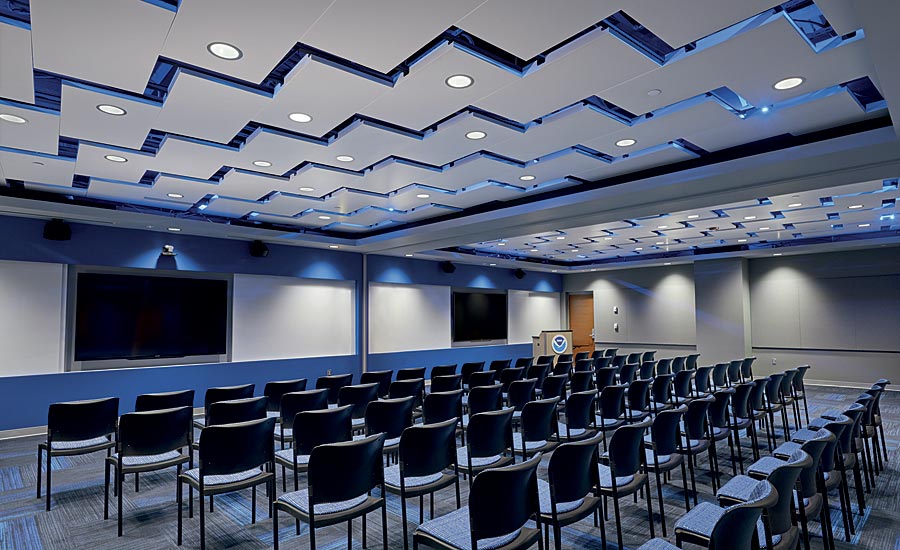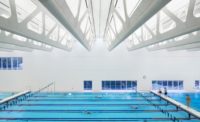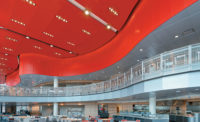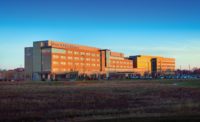The National Oceanic and Atmospheric Administration’s National Logistics & Reconditioning Center in Grandview, Mo., is responsible for the repair of all the radar systems and other forecasting equipment used by the National Weather Service’s stations internationally. Originally located in a facility built in the 1930s, the center is now housed in a newly constructed 238,000 square foot building.
At the new facility, the main conference room is used to host everything from briefings and training sessions to tour groups and national meetings. As a result, the design team at Burns & McDonnell, Kansas City, Mo., felt it was important to create a space that would not only embody the center’s mission but also provide the staff with a space they could be proud of.
First Impressions Last
“We wanted to create a space that would leave a lasting impression of the facility,” states senior interior designer, Rhonda Hulkill, “and the best opportunity for making an impression is the ceiling.”
The design team originally considered suspending clouds from the ceiling, but that was not feasible because the space also serves as the facility’s storm shelter and there was not enough ceiling height. “To be effective, clouds need volume and we just didn’t have the space,” Hulkill notes.
Then, working in collaboration with the You Inspire Solution Center at Armstrong Ceiling Solutions, the design team achieved its goal by creating a ceiling featuring custom 2 feet by 4 feet Armstrong MetalWorks RH215 ceiling panels installed diagonally across the room in a herringbone type of pattern.
The result is a visual reminiscence of lightning bolts coming down from the sky. A 6-inch gap separates each of the lightning bolts, while soft blue fluorescent lighting behind the panels represents the sky and adds even more interest to the ceiling visual.
All of the panels are perforated and backed with an acoustical fleece to provide sound absorption in the room. “Considering the multiple uses of the space, acoustical performance was a key consideration,” Hulkill says.
Metal Ceilings were the Best Bet
According to associate architect, Vicky Borchers, the MetalWorks ceiling panels were chosen because of their durability and reflectivity. “We wanted a certain amount of reflectance to extend the blue light into the room and give the space more life. This effect would not have been possible with standard acoustical ceiling tile. Because the panels are floating, we also wanted sharp, crisp edges since they are visible.”
As far as making an impression, Borchers reports that the conference room has become the facility’s signature space. “It is definitely the space everybody remembers and also the first place the staff takes everyone.”
Installation Presented Challenges
When it came to the installation of the ceiling, Kevin Legg of K.D. Christian Construction in Stilwell, Kan., the acoustical contractor on the job, notes the lightning bolt layout presented a number of challenges.
Because the ceiling was not parallel with the wall, it was difficult to take measurements off the wall to establish key grid marks. To remedy this, his crew traced the grid layout on the floor using different colored chalks and then used a laser to transfer the marks up to the ceiling.
The layout also had an effect on the lighting. “So that the can lights did not interfere with the grid, we had to lay the ceiling out first and then the electrician told us where to cut the fixture opening in each ceiling panel,” Legg explains.
Diagonal Layout Increased Difficulty
Another challenge was the diagonal nature of the ceiling layout itself. “The panels are about 15 degrees out of parallel with the walls,” Legg continues. “The non-square nature of the layout meant cutting the panels at the perimeter was much more difficult than usual.”
In addition, an operable partition that can divide the room into separate spaces runs down the center of the room. The ceiling layouts on each side of the partition are at opposite angles. “While this looks great aesthetically,” notes the contractor, “it did not make it any easier for us.”
The perimeter presented another challenge because the ceiling is suspended over a drywall soffit that is cantilevered underneath it so that none of the ceiling panels actually abuts a wall. As a result, the contractor had to install a floating edge detail around the entire perimeter.
Finally, Legg notes that except for the panels with a penetration in them, the panels also had to be removable to allow access to the space above the ceiling. “Half of each panel had to butt up against an adjacent panel, but we could not use any mechanical fasteners
to attach one panel to another,”
he states.






